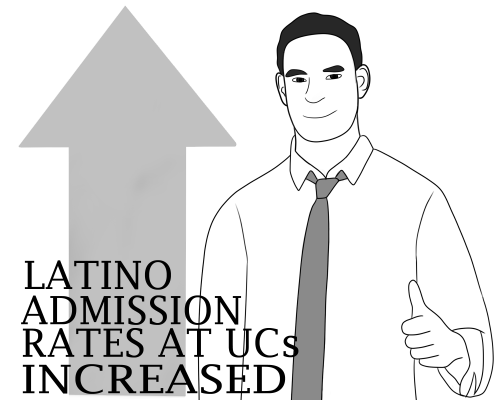Increase of Latino Presence on UC Campuses
DENISE TIEU
CINDY LUO
News Editors
As the percentage of Latino high school graduates increases, as shown by a study conducted by the U.S. Department of Education, the amount of in-state Latino students accepted into Universities of California (UCs) has also risen for the 2014-2015 school year. With 28.8 percent of Latino applicants being enrolled into UCs, Latinos—for the first time—have been admitted more than Caucasian applicants, making them the second most accepted ethnicity, according to the Huffington Post.
“This does in fact engender my views on Latinos [that instead of being] the individuals who drop out of school, [they] actually strive for an education. […] Being a Latino, [hearing] this outcome is truly amazing,” senior Antonik Karayan said.
The increasing acceptance rate of Latino students corresponds with the group’s population growth statewide. According to Governor Jerry Brown’s state budget released last January, Latinos were projected to become the largest single ethnic group in the state by last March, surpassing Caucasians, making up 39 percent of the state’s population, compared to 32.3 percent in 2000.
“Knowing that there was an increase in the amount of Latino students being accepted to UCs makes applying to a UC a little less intimidating,” senior Laura Salazar said.
In 2000, the high school dropout rate of Latinos was 28 percent; by 2011, the percentage went down to 14 percent, according to the National Public Radio (NPR).
“[UCs accepting more Latinos] shows how Latinos actually have more to them than what other people think. It’s giving Latinos a better chance in getting a job and helping their family. It’s helping them achieve their dreams that they moved here for,” senior Ilias Castro said.
By 2012, seven out of ten Latino high school graduates, or 69 percent of their population, were enrolled in either a two year or four year college, an increase from 49 percent in 2000. In comparison, 67 percent of Caucasian students headed to college in the same year, a three percent increase from 2000.
“I think stereotypes that say Latinos won’t go anywhere will [diminish] because of Latino students’ academic achievements. Instead of being praised as a certain race, they are praised as individuals,” senior Renata Rodriguez said.
Researchers attribute the rise in number of Latinos enrolling in college to the declining economy or changing familial values. The rate of Latino high school graduates going on to college has increased since 2008.
“Seeing the Latinos and Latinas achieving in their lives definitely inspires me to strive to be one of them,” sophomore Raquel Meza said.
As stated by the Washington Post, since the Great Recession, Latino unemployment rates of individuals between 16 and 24 years old have increased by seven percent. In addition, 88 percent of Latinos, 16 years or older, believe that getting a college degree is important in life.
“Awesome! Things are finally changing,” World Languages Department Chair Alejandra Perez said.
